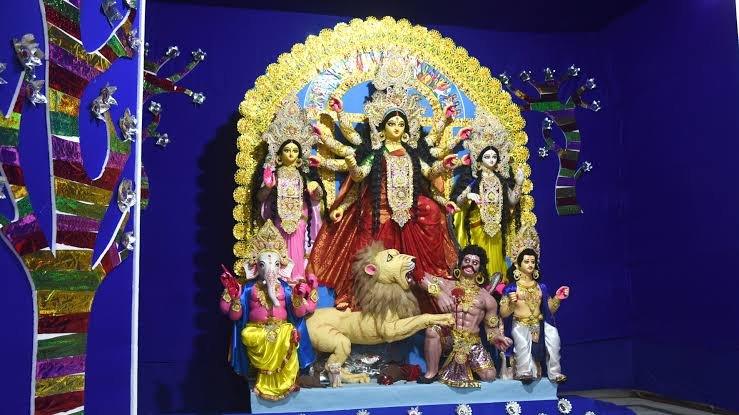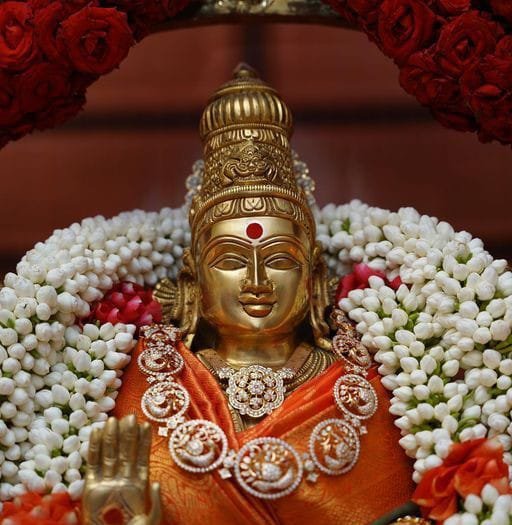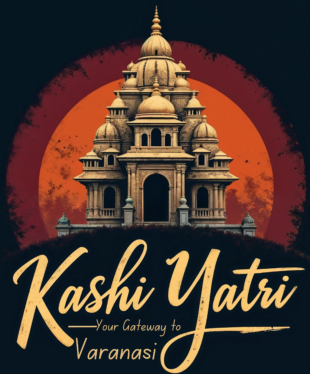The Festival of Navratri in Varanasi
In India, the festival of Navratri is celebrated with great fervor and reverence, as it is considered to be one of the most treasured Hindu holidays. In the city of temples that is Varanasi, the festival of Navratri has a very particular place in the hearts of the people who live there. A significant highlight of the event is the Vaishno Devi darbar that is held at Townhall, Maidanagin. This darbar is hosted by the SB Durga Utsav Samiti and is one among the many activities that are taking place.

Over the course of twenty-five years, this festival has become a tradition that attracts hundreds of devotees who come together to offer their prayers to the Mother Goddess in a pandal that has been exquisitely decorated. This year, like they do every year, the committee has gone above and beyond to bring a little bit of Jammu to Varanasi. They have done this by putting the revered “pindi” (holy stone) from the original Vaishno Devi shrine in Jammu, along with a silver idol of the goddess.
We are going to go into the significance of this festival, the traditions that are involved, and the passion that it elicits in the hearts of the people in this post. We will investigate the ways in which the Vaishno Devi darbar at Maidanagin continues to build the spiritual and cultural fabric of Varanasi by taking a comprehensive look at the rituals and activities that take place there.
The splendor of the Vaishno Devi Darbar in Varanasi is a topic of discussion
Every year, Navratri alters the landscape of Varanasi with its vivid celebrations. The SB Durga Utsav Samiti in Townhall, Maidanagin, is famed for put up one of the most spectacular and revered pandals dedicated to Vaishno Devi. This enormous pandal is covered with beautiful decorations, lights, and flowers, creating a sublime environment that transports devotees to the sacred Vaishno Devi shrine in Jammu.
The pandal this year is particularly notable, as it involves a pindi brought all the way from Jammu. The pindi symbolizes the divine figure of the goddess Vaishno Devi, venerated by millions of devotees who undertake the difficult pilgrimage to her cave shrine in the Trikuta Mountains of Jammu and Kashmir. For those who cannot make the journey, this pandal provides a unique opportunity to enjoy the blessings of the goddess in Varanasi itself.
Alongside the pindi, the silver idol of Goddess Vaishno Devi is worshipped with utmost devotion. The sight of the intricately made idol, gleaming in the light of the pandal, is awe-inspiring. The idol, which is a constant element of the festival, is adored as a symbol of strength, purity, and protection. Devotees gather to the pandal, bringing flowers, coconuts, and sweets, seeking the blessings of the goddess for health, money, and prosperity.
Rituals and Offerings: A Deep Dive into the Sacred Practices
The ceremonies undertaken at the Vaishno Devi darbar at Townhall, Maidanagin, are steeped in tradition and devotion. From the very first day of Navratri, the pran pratishtha (consecration) of the silver idol of Goddess Jagdamba, another form of Goddess Durga, is performed. This ceremony marks the spiritual awakening of the idol, making it a receptacle of heavenly power. The consecration is done out by knowledgeable priests utilizing sacred mantras, flowers, and holy water from the Ganges, a venerated river in Hinduism.

One of the most important ceremonies held here is the daily Chandi Path, a Vedic song devoted to Goddess Durga, recited by highly trained Vedic Brahmins. The Chandi Path is thought to invoke the goddess’s heavenly power and blessings, and it is conducted to assure the well-being and prosperity of all believers. The chanting of the hymns fills the pandal with an aura of spirituality, producing a tranquil and reverent mood.
Devotion and Faith: The Crowds at Vaishno Devi Darbar
Since the beginning of Navratri, the pandal at Townhall, Maidanagin, has witnessed a tremendous influx of devotees from around Varanasi and nearby districts. Each day, thousands of people attend the pandal to seek blessings, give prayers, and participate in the ceremonies. The devotion is obvious as believers stand in enormous queues, shouting praises of the goddess and eagerly awaiting their turn to catch a sight of the holy.
The darshan of the silver idol and the pindi from Jammu is believed to bestow supernatural favors, and devotees come with strong confidence in the goddess’s power. For many, the darbar is not merely a religious event, but an emotional and spiritual journey that increases their connection with the Almighty. As the priests perform the daily rites, the devotees join in, their hearts overflowing with reverence and hope.
The mood at the pandal is electric, with the sound of conches, bells, and devotional chants creating a symphony of devotion. The sight of the gorgeously decorated pandal, along with the collective prayers of thousands of devotees, creates an experience that is both awe-inspiring and intensely spiritual.
The Vaishno Devi Darbar: A Tradition of 25 Years
The Vaishno Devi darbar in Townhall, Maidanagin, has been a vital component of Varanasi’s Navratri celebrations for the past 25 years. What started as a tiny gathering has grown into one of the most anticipated and revered festivals in the city. Over the years, the organizers have worked relentlessly to make each year’s celebration larger and more spiritually edifying than the last.

The custom of setting up the Vaishno Devi darbar was established by the SB Durga Utsav Samiti, a group of dedicated persons committed to fostering religious and cultural events in Varanasi. Their efforts have borne fruit, as the festival now attracts thousands of believers and has become a symbol of dedication and faith in the community.
One of the primary individuals behind this event is Lakhhan Sharma, the treasurer of the committee. In an interview, Sharma emphasized that the committee’s purpose is to offer believers an opportunity to experience the heavenly presence of Vaishno Devi in Varanasi itself. “Every year, we strive to bring something new and special for the devotees. This year, we brought the sacred pindi from Jammu, which has been a great highlight,” he said.
Special Events: The Awakening of Goddess Vaishno Devi
As the Navratri progresses, the SB Durga Utsav Samiti has lined up numerous spectacular events that are highly awaited by devotees. One of the most notable events is the Mata Rani ka Jagran, which is set to take place on the seventh day of Navratri, known as Saptami. This ceremony is a night-long vigil, during which devotees sing devotional songs and recite legends of the goddess. The atmosphere during the Jagran is one of great devotion, since the night is devoted in the adoration of Goddess Vaishno Devi.

On Ashtami, the eighth day of Navratri, a special offering of dry fruits (meva) is made to the goddess. This practice is followed by the distribution of prasad (holy offerings) to all devotees present. The Ashtami ceremonies are regarded extremely auspicious, and many devotees observe fasting on this day, breaking their fast only after partaking in the devotion.
The ninth day, Navami, signifies the completion of the Navratri festival and is celebrated with great passion. On this day, the goddess is offered halwa, a sweet dish composed of semolina, which is later distributed to the devotees in a big feast (bhandara). The bhandara is a significant feature of the festival, since it draws the community together in a common act of devotion and celebration.
Security and Safety: Ensuring a Peaceful Celebration
With the vast number of devotees attending the pandal each day, the organizers have taken special efforts to ensure the safety and security of all participants. The committee has cooperated with local authorities to ensure tight security standards at the pandal. CCTV cameras have been deployed at strategic areas, and security staff are stationed at numerous entry and departure points to monitor the throng and avoid any unpleasant situations.
In addition to the security precautions, the organizers have also ensured that proper cleanliness and hygiene are maintained at the pandal. Hand sanitizers and masks are provided to all visitors, and frequent cleaning and disinfection of the facilities are carried out to avoid the spread of illnesses, particularly in light of the COVID-19 epidemic.
Conclusion: The Spiritual Significance of Navratri at Vaishno Devi Darbar
The Vaishno Devi darbar at Townhall, Maidanagin, is not simply a religious event; it is a monument to the undying faith and devotion of the people of Varanasi. Over the years, the celebration has increased in scale and significance, gathering devotees from all walks of life to come together in the adoration of the Mother Goddess. The gorgeously decorated pandal, the solemn ceremonies, and the collective prayers of thousands of devotees create an environment of heavenly grace and spiritual upliftment.

As Navratri continues, the darbar remains a major point of celebration, providing believers a chance to connect with the divine and seek the blessings of Goddess Vaishno Devi. Through the rituals, offerings, and prayers, the festival reinforces the spiritual tie between the goddess and her devotees, reminding everyone of the power of faith, dedication, and community.
In the heart of Varanasi, the Vaishno Devi darbar stands as a beacon of holylight, guiding the believers towards a path of spiritual satisfaction and eternal blessings.







